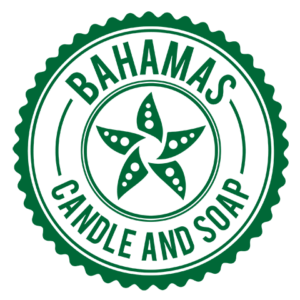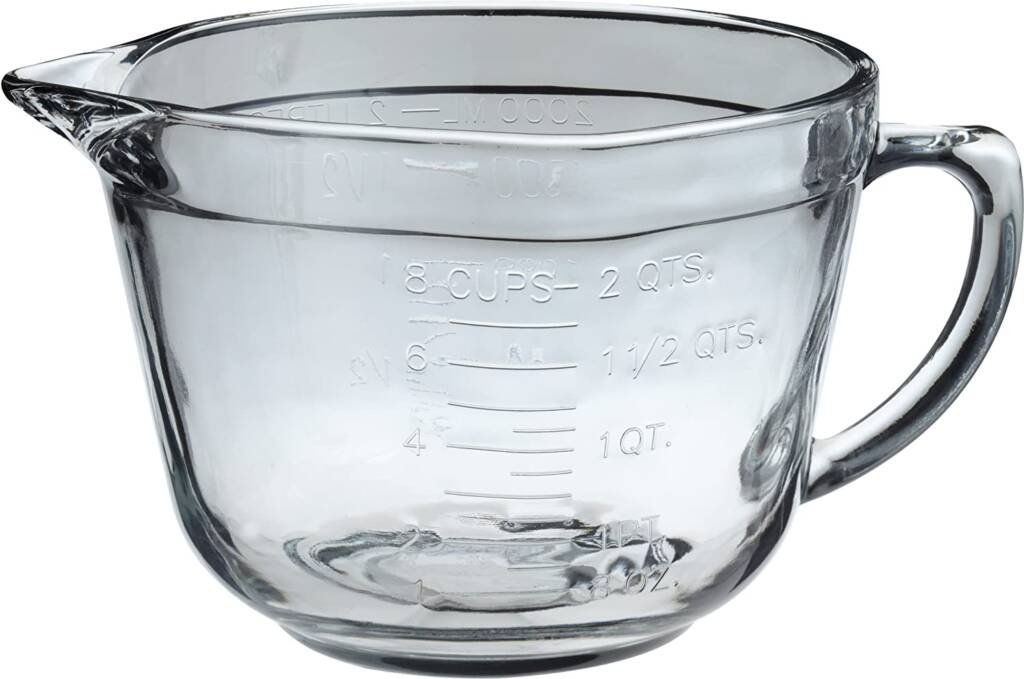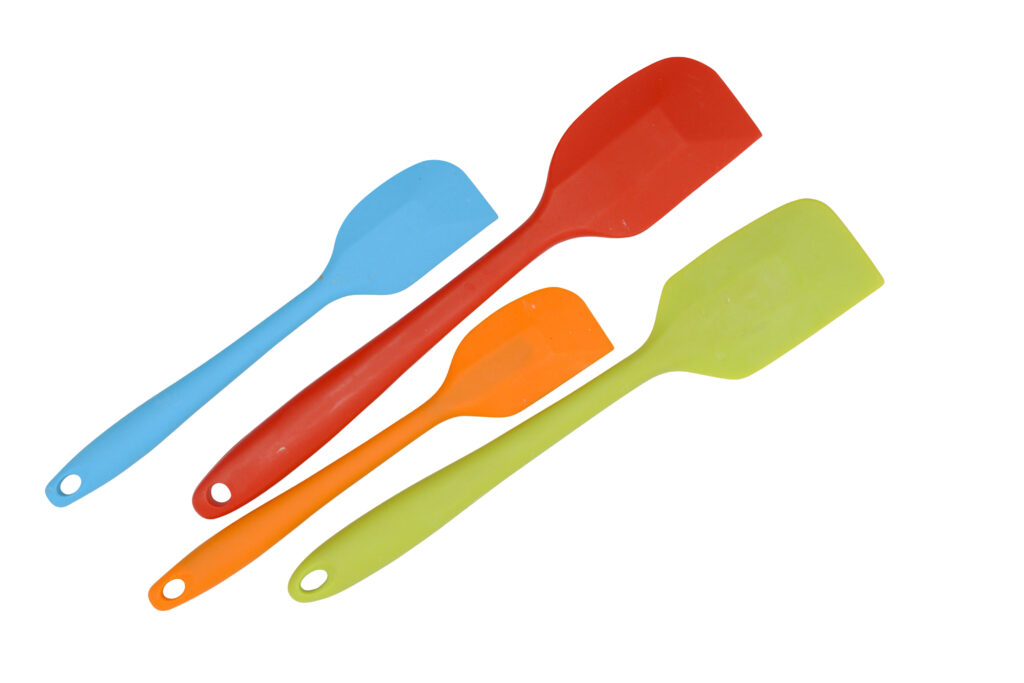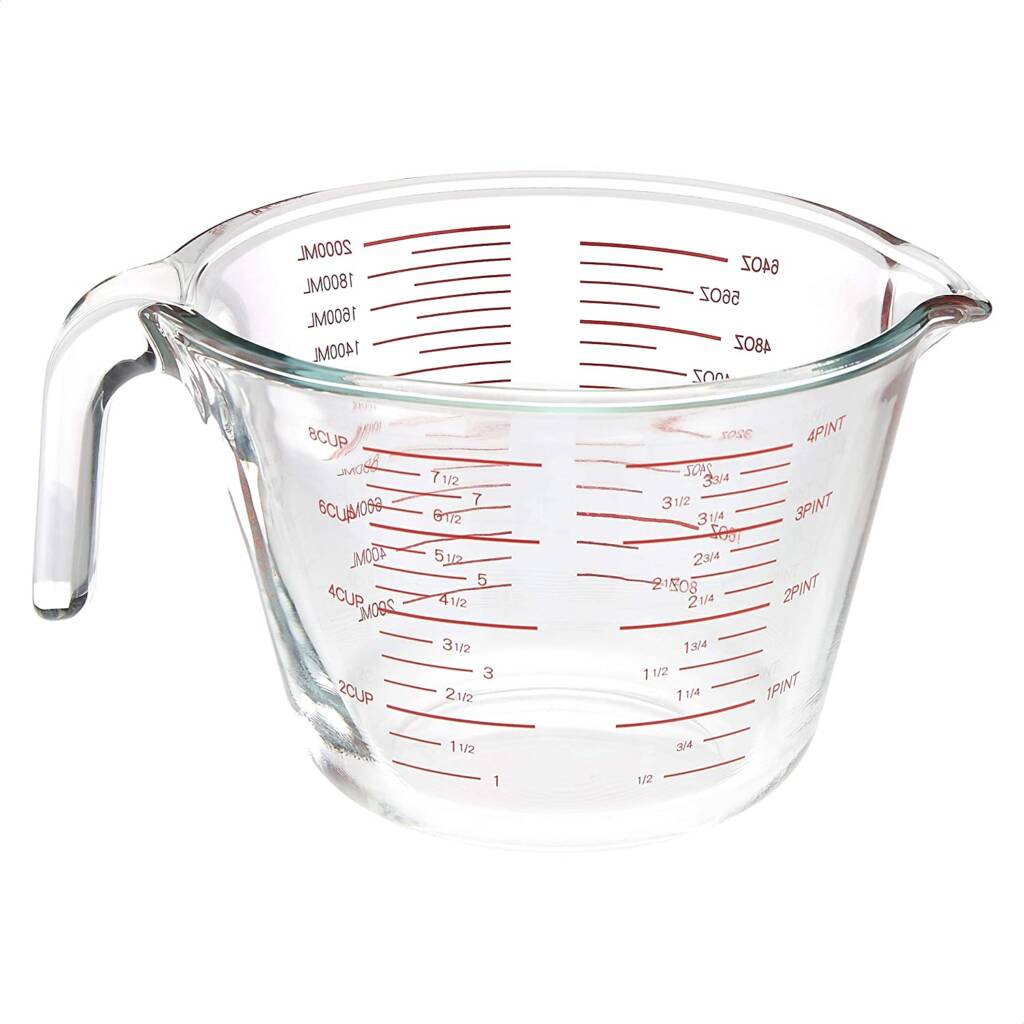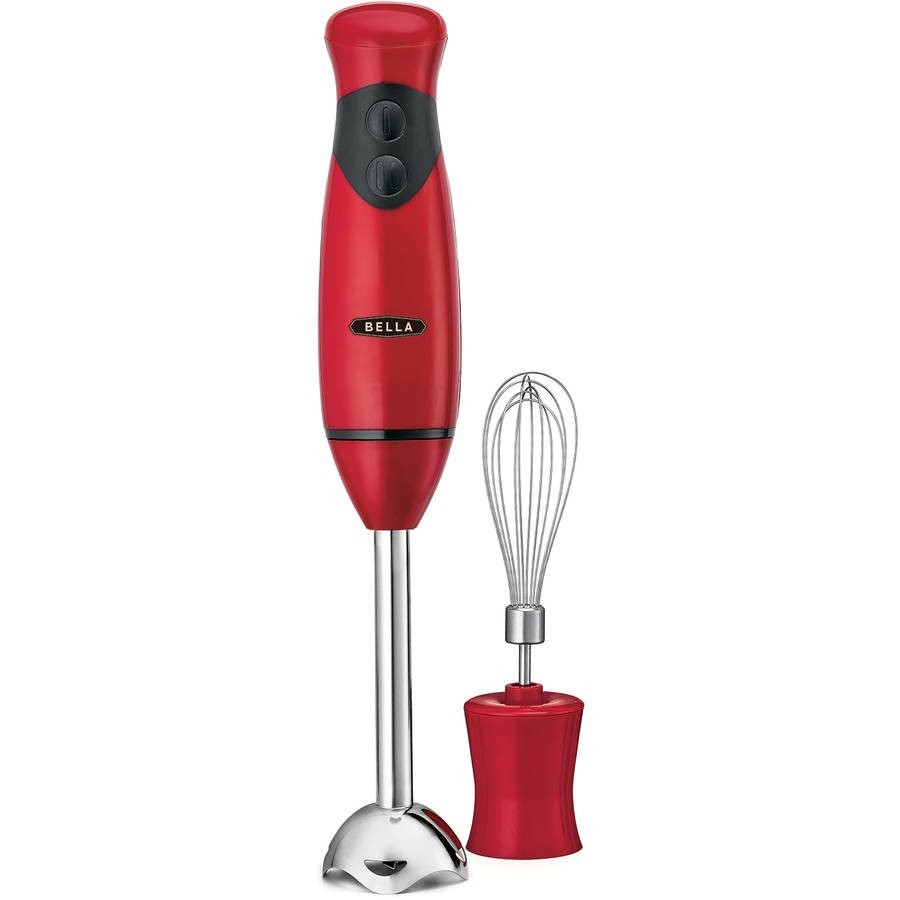Soap making level – Intermediate
In the pot soap swirl cold process technique – Introduction
The in the pot soap swirl video below was a bonus video made mainly due to a mix up of soap making classes, it was timely as we were also on the verge of making a bar for our Christmas gift boxes. Hence it all came together to make this video and do the class at about the same time.
The technique is fairly simple, In the pot soap swirl technique uses soft oils for more working time, divide and color at emulisification then mix the colors in the pot with a spatula.
The hardest part of the in the pot swirl technique is actually ensuring your soap batter is fluid enough to accept a swirl of two colors. This simply means taking your soap batter to a light medium trace.
There are a few factors to consider as well. The biggest is the fragrance or essential oil that you will use. Will it accelerate trace or not?
Fortunately for me this fragrance did not accelerate trace infact it behaved very well during the cold process soap making. This doesnt mean to say that all went well as it didnt.
I nearly forgot to add the fragrance to this batch. If you watch the video you will see that I was about to get ready to pour and realized that I had not added the fragrance. This mistake did add time to the soap making process and it made me frantically speed up my movements as I was afraid that the batter would begin to thicken.
Luckily for me I did have some thickening of the batter but not so much that I couldnt recover from it.
Table of contents
- Swirl planning
- Safety tips
- Ingredients
- Tools
- The technique
- 1 – Lye water preparation
- 2 – Oil preparation
- 3 – Color and fragrance preparation
- 4 – Oil and Lye combine
- 5 – Removing soap from mold
- Cutting and curing
- The work
In the pot soap swirl planning
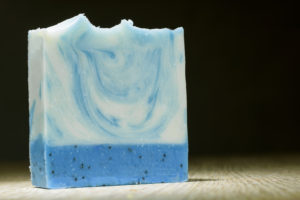
When it comes to making soap, planning is key. You have to have a good idea of what you are going to make, the look of it and the end use of the soap. This will dictate what tools you will need to make the soap you want.
In this soap making session I knew I wanted a drop swirl soap, one with green and one with red. Well because it was something for the Christmas season those colors stood out more.
The concept of the soap was simple. I will need white, green and red. The reason I say white is because as a beginner you may think that just making a plane soap will yield a white soap. Not so. Natural soap will be a yellowish color mainly due to the oils you use. Because many of my soap mixtures use predominantly Olive Oil it gives it this rich creamy look.
In the pot soap swirl making safety
The one key point that is stressed as we teach and we will stress here at Bahamas Candle and Soap is the importance of safety in candle and soap making.
When making soap you will be working with super heated materials with the potential to cause major skin burns. You must be sure that you are properly prepared.
The main ingredient in soap making is sodium hydroxide also known as lye. This corrosive chemical reacts with water and begins to heat up drastically, however this chemical reaction is needed to convert oils into soap.
It is good to make safety procedures a standard and a habit when it comes to making cold process soap. Many soap makers have stated that after making soap for a while it becomes easier and less scary once they stick to safety protocols
Sodium Hydroxide – Lye SAFETY
Sodium hydroxide is an inorganic compound used to emulsify the fats of oils into soap. When used properly in soap there will be no lye left over in the soap as its chemical makeup changes to create the actual soap.
When handling lye be sure to protect your exposed skin. Here are a few items we recommend you have.
- Gloves
- Long sleeve shirt
- Long pants
- Closed toe shoes
- Safety Goggles
These items will ensure if there are any accidents such as splashes you will keep your skin safe from the burning sensation of lye.
NOTE
- Use an appropriate container to hold your lye and to mix your lye water. Heat tempered glass works very well or hard plastic containers.
- When making your lye water remember to add the LYE to the WATER and never the other way around.
- Mix you lye solution in a well ventilated area. The fumes that will arise from mixing water and lye can become noxious to some persons while its chemical scent can burn your nose and make your eyes water.
- Ensure that you are wearing your safety glasses, rubber gloves, long sleeve shirt and pants and close toe shoes. This is to avoid any splashes getting on your skin. Another reason is that if you use a container that cannot handle the heat created by the lye water solution it could break and the entire solution can get on your body.
- Learn more about lye safety HERE
Oils
In some recipes and depending on where in the world you live you may have to pre heat your oils. Oils can also burn the skin when heated hence ensuring that you are safe from splashes or spills is very important.
This recipe uses Olive, coconut, and castor oil along with cocoa butter.
Cold process soap in the pot soap swirl ingredients
| Ingredient | Pecentage | Weight |
|---|---|---|
| Olive Oil | 56% | 19.8oz |
| Coconut Oil | 30% | 9.90oz |
| Cocoa Butter | 5% | 1.65oz |
| Castor Oil | 5% | 1.65oz |
| Distilled Water | 12.54oz | |
| Lye | 4.69oz | |
| Colorant (mica or oxidie) I will use red mica for this tuturial | 1tsp | |
| Titanium Dioxide | 1tsp | |
| Fragrance (optional) | 1.44oz | |
| Sodium Lactate (recomended) | 2tsp |
Tools needed for In the pot soap swirl cold process soap making
This is where planning comes in to play. Having all your tools at the ready is important so you are not left frantically searching for an item. In the video close to the end you see that I used a white stick to put a little texture design on the soap. This is because I forgot to have my top designed stick aka a bamboo skewer ready.
Infrared Thermomete
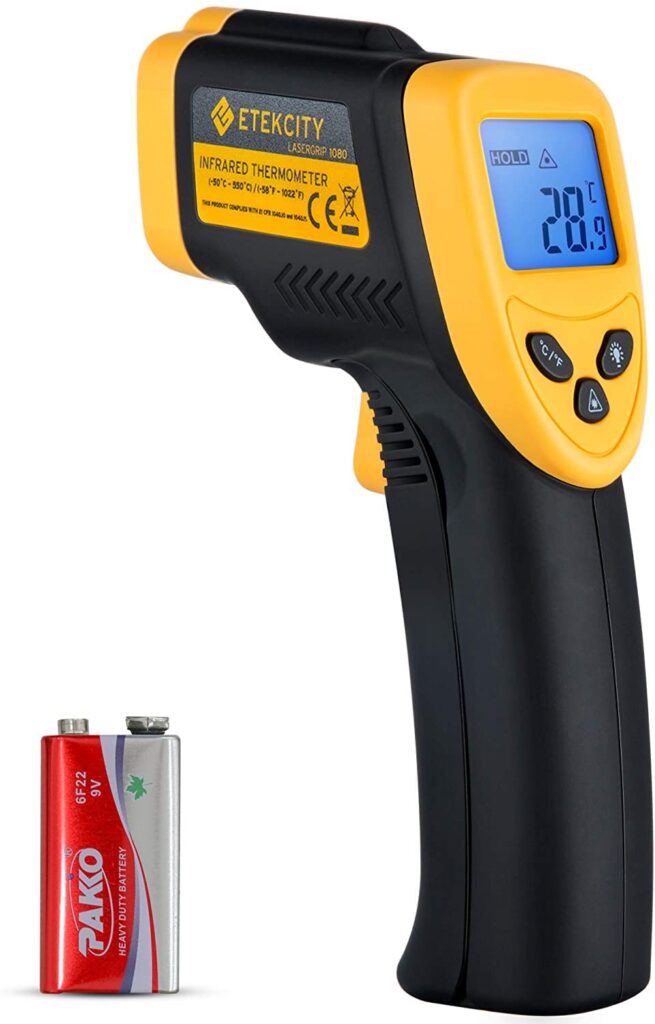
Steel whisk

Measuring spoon 1oz
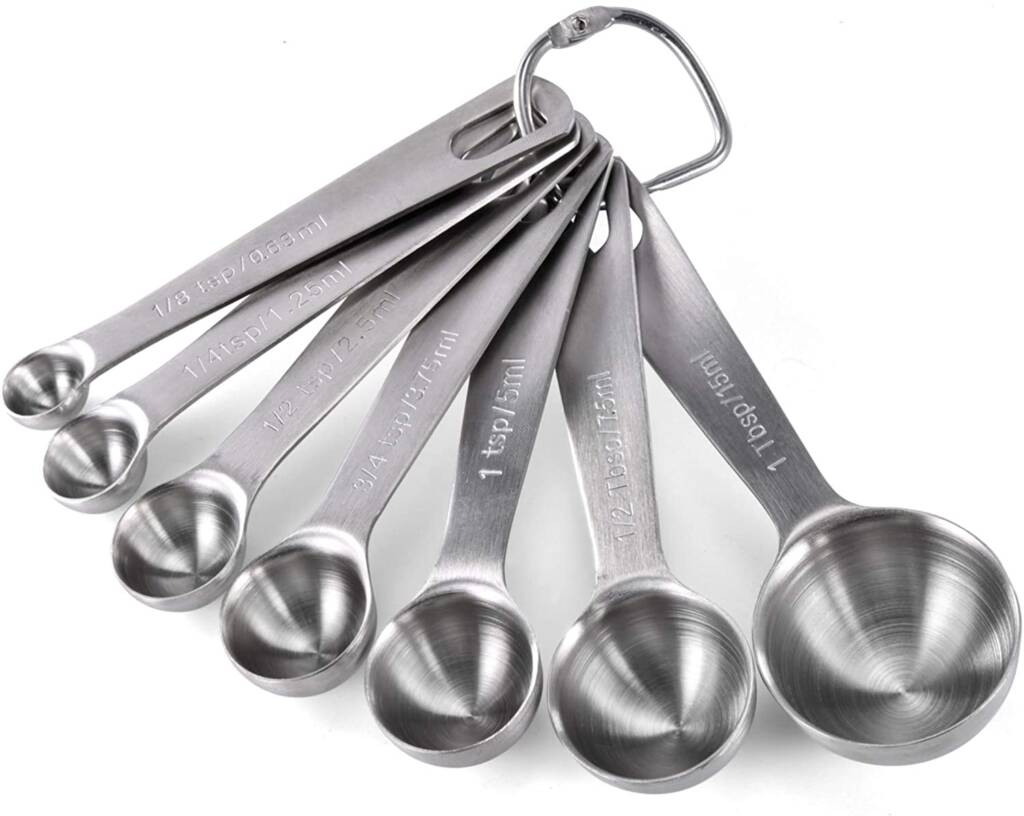
42oz loaf mold

Food grade scale
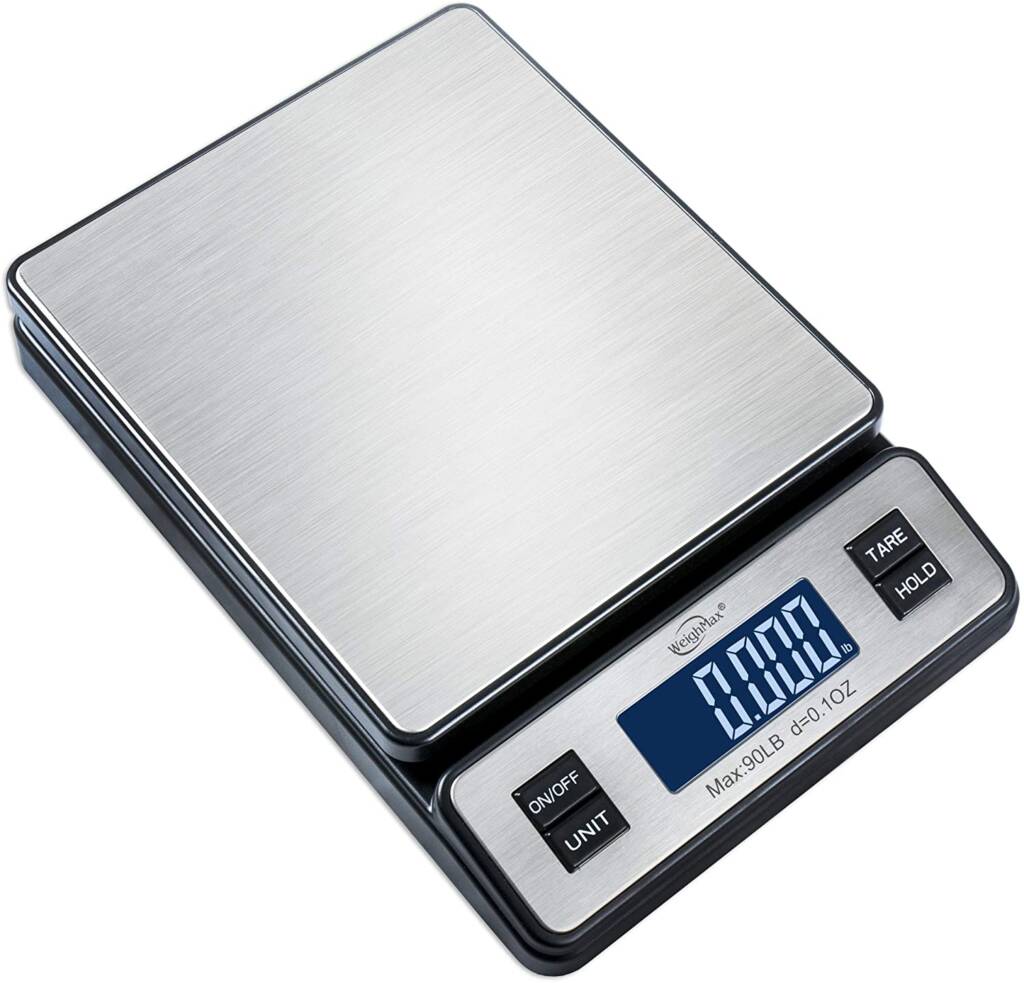
Funnel Pouring container
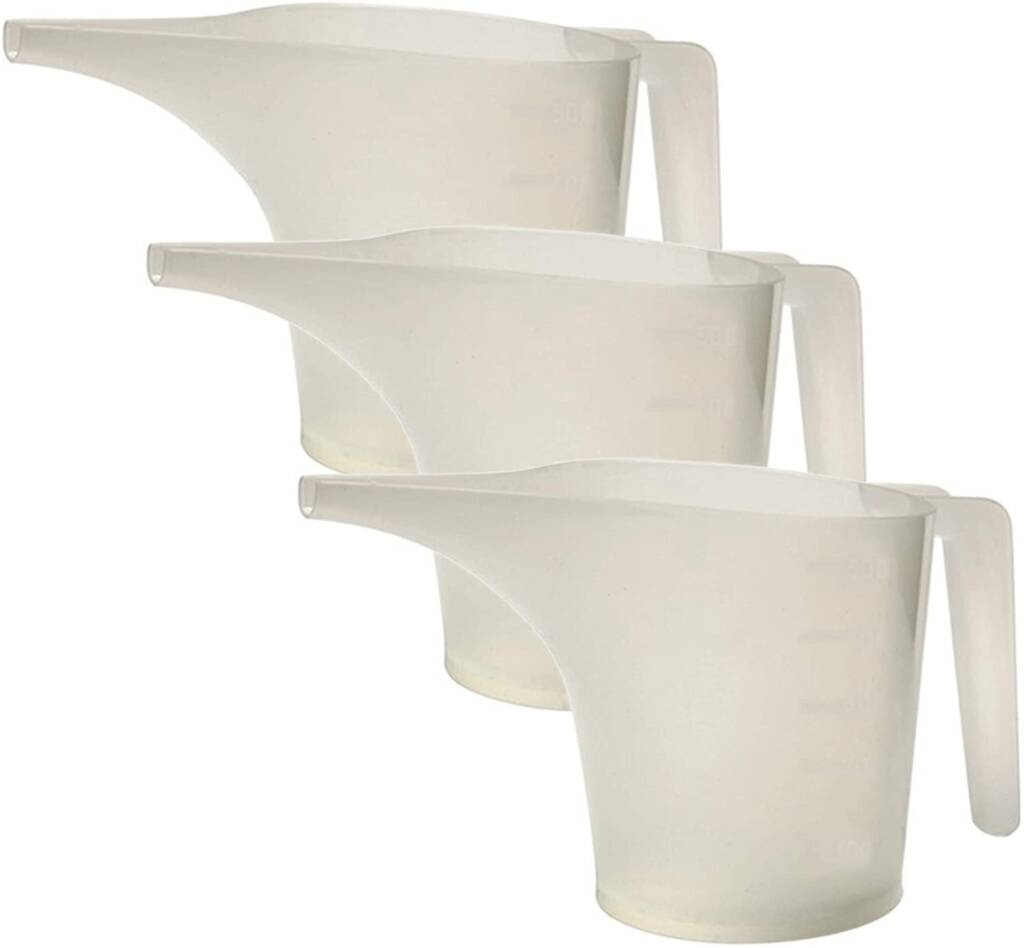
Safety Gloves
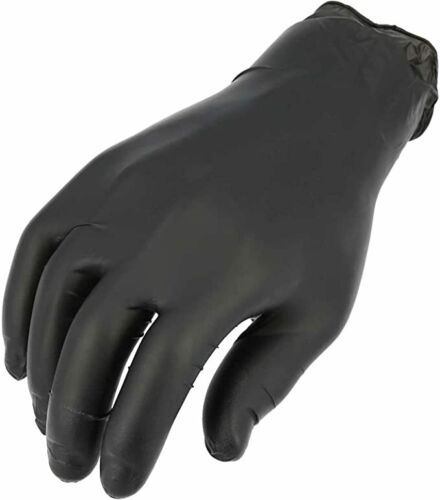
Safety glasses
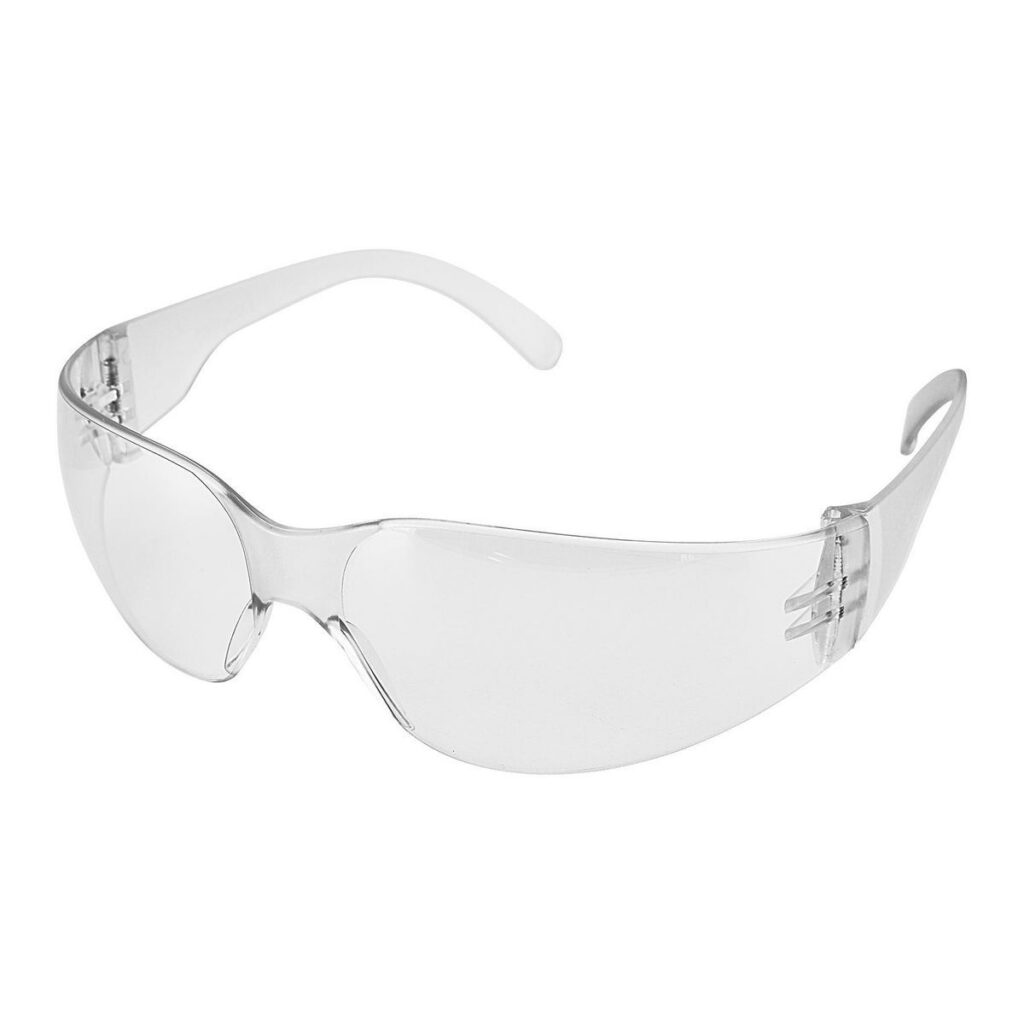
This what I needed and of course a plan of action of how to get it all done. Off camera I was following the recipe I made for this soap project and before that I had made a sketch of how I wanted the soap to look.
Put It all together instructions for in the pot soap swirl technique
Having a plan of action helps in putting it all together. What to do first, where to place items, what is needed next, where to place used tools. All this is a part of organizing your work station to ensure that you get things done right.
Eventhough I do this all the time, to make such a soap separating batter and using two different colors makes it a bit harder because there is so much to keep track of.
Making one loaf of soap can be a daunting task much less making two loaves both with different colors.
1 – Lye water preparation for cold process soap making
Remember to observe the safety protocol for handling sodium hydroxide.
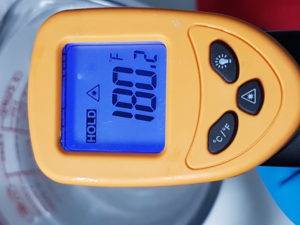
- Using your measuring cup on you scale zeroed out, measure out 12.54oz of distilled water.
- Pour out 2 oz of this distilled water into a small mixing container.(we will need this water later)
- Use your second measuring cup to weigh out 4.69oz of sodium hydroxide/lye.
- Add your lye to the water (never the other way around) slowly and mix using the steel whisk until dissolved. Check the temperature of the lye mixture once the lye has been dissolved.
- Add 2tsp of sodium lactate to the lye water mixture. If you dont have any, it is okay to skip this part
- Set your lye water to the side to cool but safely away from any accidents such as bumping the table or knocking over the measuring cup. (NOTE – depending on your location and ambient heat, you can place your lye water in the refrigerator to cool quicker. You will want to check on it every 5 minutes taking its temperature using the infrared thermometer. 120-130 degrees fahrenheit is a good temperature that you are looking for.)
Now that you have prepared your lye water you can begin preparation of your base oils.

2 – Oil preparation for in the pot soap swirl cold process soap technique
Using multiple oils can become difficult to manage especially when it comes to combining all the oils together.
If you are unfamiliar with ways to combine multiple oils into one bowl properly you can visit How to combine multiple oils for soap making and familiarize yourself with the techniques involved.
Which ever technique you use make sure you add all of your oils together in the 2qt large mixing bowl. If you did not read the article on adding oil you may have missed the part about ensuring all your oils are melted and clear.
You will need your oils in a liquid state and at the right temperature roughly between 80-120 degrees fahrenheit, before continuing. Again if you are not sure how to do this skip over to the other article How to combine multiple oils for soap making.
IMPORTANT NOTE – Measure out 1oz of olive oil into your funnel pouring pitcher. This will be used later
With all you oils combined in the mixing bowl I find it a good practice to stir the oils together either with a spatula or more vigorously with a stick blender the more oils used. This is to ensure that the oils marry well within the mixture and are prepared for the lye water.
Combine all you oils into the mixing bowl, Olive, coconut and castor oil. Cocoa butter no matter your climate will require heating to melt it prior to adding it to the other oils.
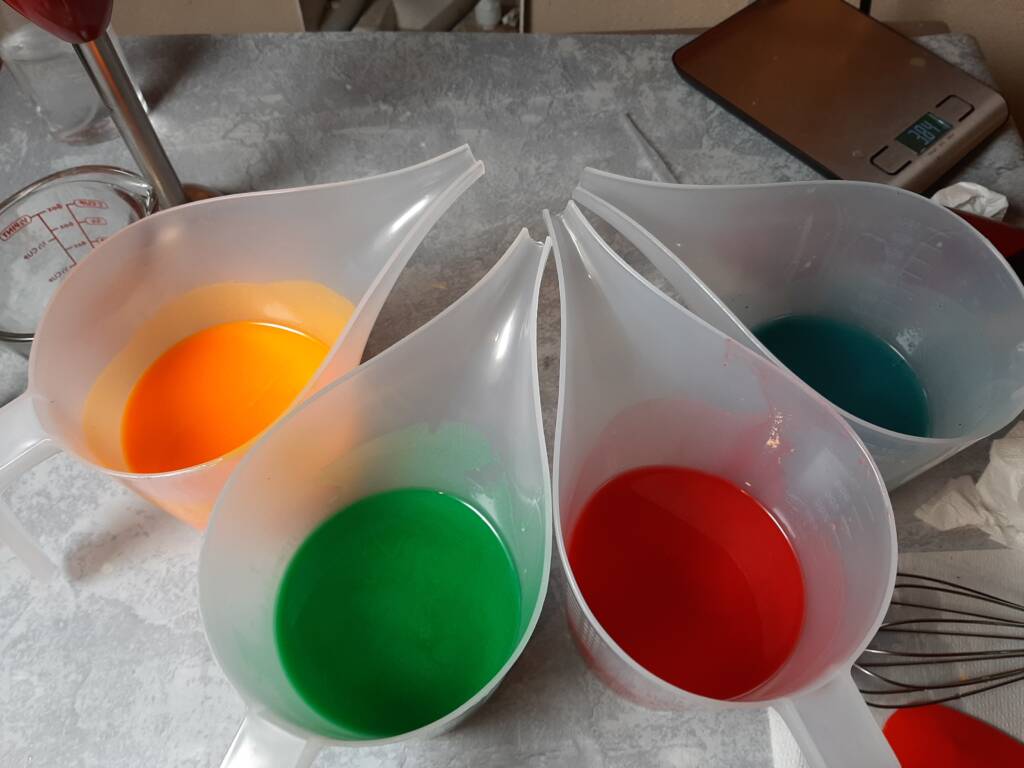
3 – Colorant and fragrance preparation
For this tuturial I used red mica and titanium dioxide. The green in the video was green oxide.
Unlike the video I will give you a better way to prepare your colorants. Rembeber the 2oz of distilled water you took out earlier along with the 1oz of olive oil? Preparing the color is where they are used.
- Warm the 2oz of distilled water in the microwave, about 20-30sec will do.
- Add 2tsp of titatium dioxide to the water. (TD tends to disperse easier in warm water than cooled water and even oil)
- Stir the TD and water thouroughly to remove any clumps that may have existed. Place this container on the side.
- Add 1tsp of red mica to the 1oz of olive oil you set aside earlier.
- Stir this color together until the mica is evenly dispersed in the oil. Set this aside for later.
- Measure out your fragrance oil into a separate container and set it aside with the colored container.
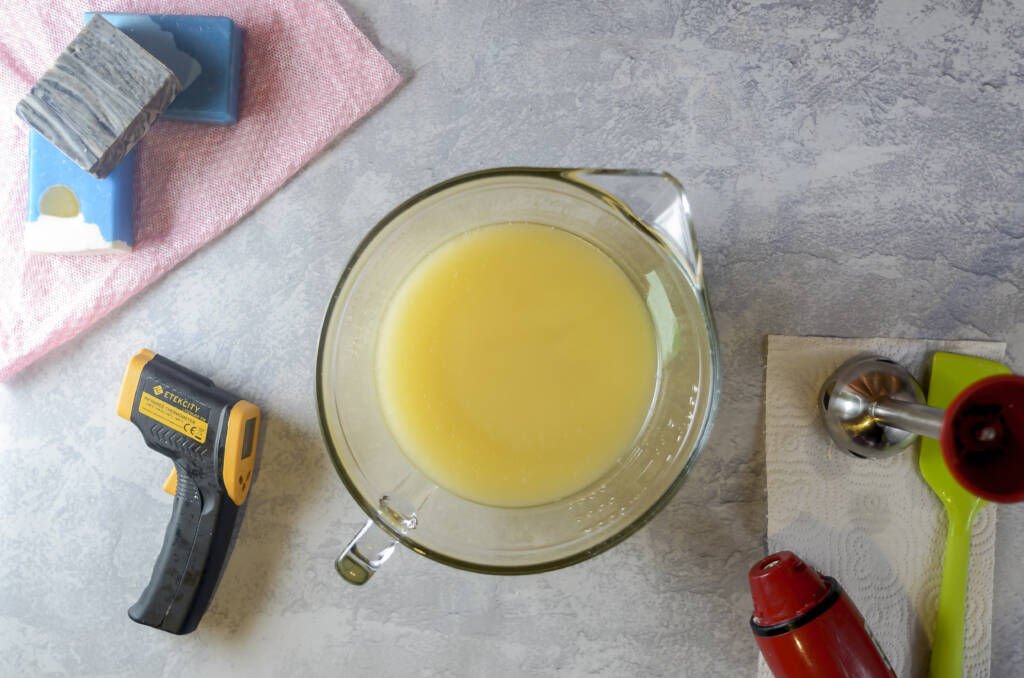
4 – Oil and Lye Mixture combination making in the pot swirl soap
- Take note of the temperature of your oils and your lye water. At this point they both should be between 80-100 degrees fahrenheit but closer to 100-120.
- With your stick blender in your oils well burped, pour your lye water into your oil mixture along the stick blender to prevent bubbles.
- Begin to blend the lye water and oils together with short pulses from your stick blender and then longer sustained mixing.
- Mix your batter until you have reached emulsification. This comes before light trace. It can be difficult to spot for a novice but once the oil and lye water has completely combined where you so not see any more oil streaks.. you have reached emulsification.
Soap batter separation
- Separate your emulsified soap batter into the container with the red mica and olive oil…but by weight.
- Typically a ratio of 70/30 works best. 70% your main color and 30% your secondary color.
- If you look on your soap recipe pdf file you will see that the total weight of your soap will be 51.67oz. 30% of this is 20.50oz for your red soap portion.
- Pour out by weight 20.50oz of emulsified soap batter into the color funnel container.
- Add your fragrance by sight to each batch, you can separate it by weight if you choose using the 70/30 rule but “eye balling ” it can work as well.
- Add the liquified titantium dioxide to your main batch of soap batter.
- Stick blend the main batch to incorporate the liqified titanium dioxide to make that batch white. Stick blend to a light trace.
- Clean off your stick blender and stick blend the red separated batch to a medium light trace.
- Using your whisk stir the main batch to keep it fluid. The key here is to have your main batch at a lighter trace than your colored batch.
- Using the funnel pitcher of red soap batter, pour it into the main batch in three sections and at three heights.
- Pick three sections around the main bowl to pour your colored batter.
- You will pour low to the main batch then at medium height and then at a higer height. This will alow the colored batter to be poured closer to the top, the middle and deeper into the main batch. THIS IS AN IMPORTANT PART OF THE TECHNIQUE.
- Once all the color is in the main bowl, use your spatula and dip it into the shallow color portions and make two circular stirs around the bowl mixing the red and white.
Making the pour
- Pour mixed colors of soap batter into the loaf mold slowly moving from one end to the other. You should see the colors pour out already swirled together.
- Ensure you scrape out any remaining batter into the mold. Tap the mold on your work bench to remove any bubbles from the poured batter.
- You can design the top as needed using which ever tool you like. I tend to use a bamboo skewer.
- Depending on ambient temperature of your work room, cover with cardboard or wax paper over top then put to bed with towels to go through trace. (NOTE – If in a room at 75deg or more leave open and exposed as putting it to bed with a covering will most likely cause it to overheat and volcano. If in a cooler room cover the soap to let its own heat help take it to gel phase for brighter colors.)
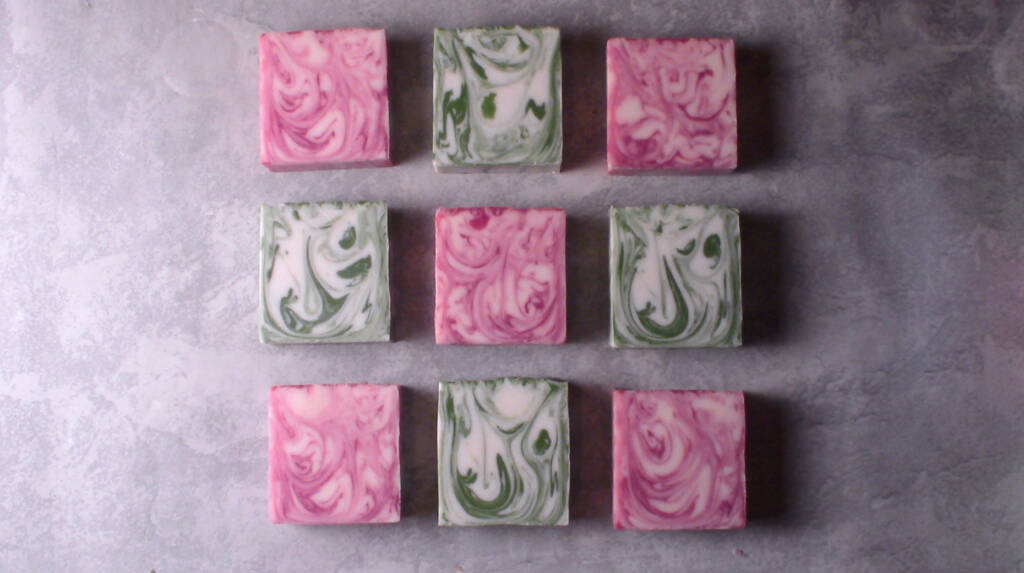
5 -Removing your swirl soap from the mold
- Let you soap sit for 24 hours before removing from the mold.
- Check its readiness to be handled and removed by pressing lightly on the top of the soap. It should be slightly hard to the touch, if you used sodium lactate it will make unmolding easier but the cocoa butter will also help harden the soap. (NOTE because there is over 50% soft oils in this recipe it may take longer to harden and unmold)
- After 24 hours and the soap has not hardened enough, you can place in the refrigerator for an hour to cool to a point to make it easier to remove from the mold without damaging the soap.
- After cooling remove the silicon and soap from the wooden mold by turning the mold upside down. The silicone part should slide out easily.
- Pull the sides of the silicone mold away from the soap slowly. If it looks sticky as you pull place the soap back into the refrigerator. If not continue to gently pull the sides away from the soap.
- Once all four sides are pulled away turn the silicone mold upside down and while pulling at the two narrow end of the silicone press down gently on the bottom of the silicone onto the soap.(this will help release the soap from the mold)
- As the soap begins to slide out of the mold help it along the way by pushing on the bottom of the mold until it slides completely out of the mold.
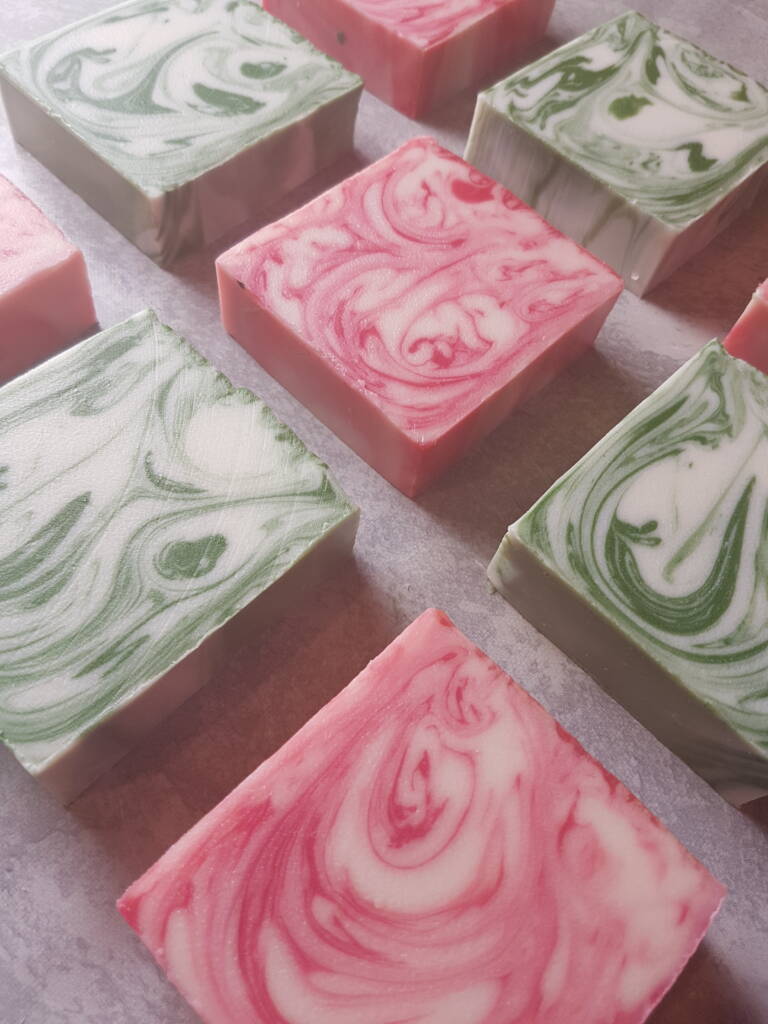
6 – Cutting and curing in the pot soap swirl bar
Un-molding and cutting the soap is the moment of truth for your technique. It is an exiting and nerve racking experience, did I make it right? Will It come out how I planned and imagined? What will it look like?
Cutting your soap is completely up to you. You can cut as thick or as thin as you like. The most standard thickness is often at 1 inch. For a typical soap loaf this will yield 10 bars of soap.
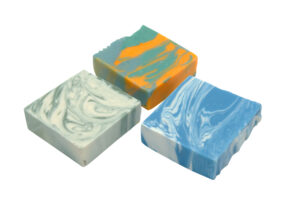
- Cut your soap using a soap cutter, a knife dedicated to soap cutting or a wire cheese/soap cutter.
- Cut them 1 in thick, or to any thickness you like (Just do not leave it as one full loaf for long, the longer you wait the harder it becomes to cut the soap because it will begin to cure and get harder)
- Let your soap bars sit in a cool dry place for 6-8 weeks to cure. (Curing removes the excess water from the soap, this causes the soap to last longer.)
- Rotate your soap, changing the part that it sits on around to allow even evaporation of water from your soap.
- If you want to track its rate of curing you can weigh the soap bar directly after cutting it and over the next few weeks weight it again. When the weight becomes negligible to track your curing process has completed.
The reaveal jitters
That first cut is like holding your breath. You just dont know sometimes even tho you may have done it many times before. Its hard to predict how a swirl will work out but one thing you dont want is for your colors to blend into each other
The last fear is after the curing process… Was my recipe good? Will I get the type of lather I wanted. Will it be as moisturizing as I planned or did I make a mistake. Did I use the right amount of fragrance? Is it too mild or too strong? This and many more questions come to mind until you test that first bar of soap on your own skin.
For us as Bahamas Candle and Soap, We not only test on ourselves but we do a ph balance test, moisturizing test and a few others to ensure our soap is safe to use and it does its job well.
The Work
Putting in the work is the fun part. Its when the creative juices are flowing and you get to enjoy making something yourself. The swirl technique used here is just one of three that can be used. This one is called a drop swirl technique. The technique it self is pretty easy to figure out but its the one part that is missing that makes it hard for most beginners to figure out.
The recipe. This is where it breaks down to what you can do or what technique you can use. Depending on the recipe and the intended use afterwards things can get a bit complicated. More on this later.
So the concept for the work was simple. Mix one big batter. Separate the batter into smaller containers for the color then use the larger batter to make the swirls.
What went wrong

A few things I missed in preparing. I should have premixed my colors instead of adding them directly to the batter. It can work either way but the problem is incorporating the color properly in to the batter. By not premixing it would thicken the batter more. So yeah that was an issue.
Secondly I should have used two separate bowl when separating the white batter and dropping the colors in. Using the larger pot make it harder to get a good drop and swirl. Honestly I knew the problem once I reached that bridge and had to adjust.
Making the red and white soap was a bit harder because the batter was thicker than the green and white. I had to clean up the tools as to not get green in the red, add the fragrance last which caused me to mix free hand to avoid an overly thick batter.
Trace is important, you have to know the thickness of each and adjust. The red was at thin trace but the white was at medium so I had to make it thicker and heavier to drop into the bowl. That took a while.
In the planning process I knew how I wanted the top to look so that was in my mind and I didn’t not forget it. Sort of a Taiwanese swirl look to go with the drop swirl.
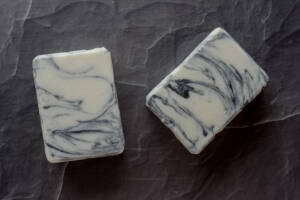
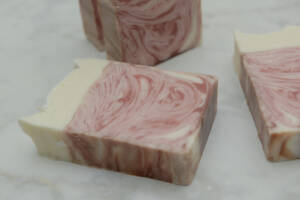
Congratulations on making your first in the pot swirl soap
This is an intermediat technique in the cold process soap making world. Practice of this techinque will take your soap making skills up a knotch.
Try this techniqe a few more times, adust the recipe if needd to suit your taste and try out differenct methods of coloring your soap and fragrances. Its bes to use a fragrance that does not accelerate trace and does not discollor.
This way you can add the fragrance to the base oils in the begining and not worry about adding it later.
We would love to hear your success stories or if you are having trouble we would love to help you our.
